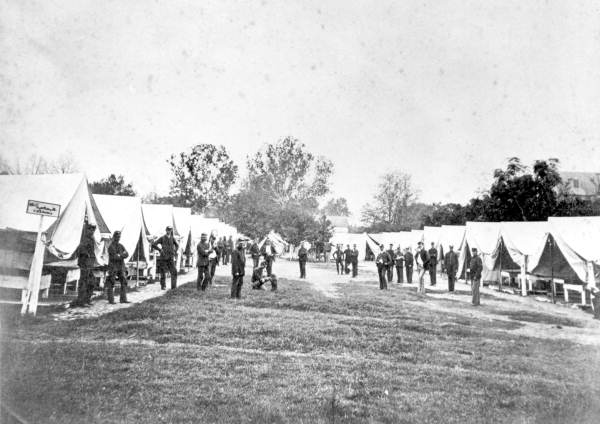Description of previous item
Description of next item
March 1862: Invasion!
Published April 4, 2012 by Florida Memory
The arrival of a Union invasion fleet off Amelia Island on March 3, 1862, was a startling but not unexpected event. As early as October 1861, Governor John Milton notified neighboring Confederate governors that a Union invasion fleet was steaming southward for a possible landing in Florida. Although the fleet’s target at that time was Port Royal, South Carolina, not Florida, ships from the flotilla eventually transported the Union expeditionary force that descended on Amelia Island in March.
For months, east coast Confederate and Unionist Floridians had expected Federal troops to land in Florida. Although a Federal raiding party occupied the Gulf port of Cedar Key in January 1862, under orders from General Robert E. Lee, General James H. Trapier, the commander of Confederate forces in the Department of Middle and East Florida (the area from the Atlantic to the Choctawhatchee River in the west), concentrated the bulk of his forces for the defense of Amelia Island. Meanwhile in Jacksonville, a city with a strong Unionist element, pro-Union men and women awaited the liberation of their city, where many of them were threatened by secessionist vigilance committees.
By March 1862, however, the Unionists had more cause for optimism than the secessionists. Confederate defeats in Tennessee during February resulted in the Richmond government’s decision to withdraw its troops from Florida to reinforce Tennessee. As the Union fleet approached, General Trapier ordered the withdrawal of his troops from Amelia Island. On March 4, the Federals occupied Fernandina after the last train carrying troops and fleeing civilians crossed the bridge to the mainland under the fire of the USS Ottawa, a Union gunboat. Fernandina remained under Union control for the rest of the war and became a place of refuge for hundreds of escaped slaves from Florida and southeast Georgia.
The Union followed up its capture of Amelia Island with an advance down the coast towards Jacksonville, St. Augustine, and New Smyrna. Confederate disarray and a lack of defensive preparations at the mouth of the St. Johns River allowed a Union flotilla to land the 4th New Hampshire Regiment and occupy Jacksonville on March 12. The New Hampshire men encountered a largely deserted city clouded in smoke from fires set by retreating Rebels. The day before, the Union also seized St. Augustine without a fight; the old Spanish capital remained under Northern control for the duration of the war. The Union forces that landed at New Smyrna were not as lucky, however. Confederate forces guarding cargo from a recently successful blockade running mission ambushed the Union raiding party, killing several Federal sailors in the brief engagement.
As Unionists in Jacksonville and St. Augustine celebrated, fear and recrimination spread across Confederate Florida. Politicians and the populace blamed General Trapier for the fall of Amelia Island. Even though Trapier had been under orders to evacuate, the hasty withdrawal and the Union seizure of the island resulted in Trapier’s removal from command. In Tallahassee, Governor Milton blamed the Confederate government and Florida’s secession convention for the defeat and Florida’s poor defenses. Milton never thought Amelia Island could have been defended in the face of the Union’s naval superiority. He wanted the Confederacy to concentrate on the defense of Middle Florida, especially Apalachicola, which he saw as the key to Florida’s control of the interior from the Gulf Coast to the Georgia border. Once the Confederate government ordered most of its troops out of Florida, it was only a matter of time before Apalachicola stood defenseless.
In January 1862, the secession convention, which resumed its session in Tallahassee largely to oppose Governor Milton’s policies, passed an ordinance calling for the abolishment of Florida’s State military forces by March 10, 1862. The convention believed the state troops were too costly to maintain and no longer needed since the Confederate government had assumed responsibility for Florida’s defense. Of course this decision was made before Richmond decided to withdraw its regiments from Florida.
Now, with the Confederate troops ordered out of Florida, the commander of the state forces in Apalachicola decided to remove the cannon protecting the port to a more defensible position at Ricco’s Bluff upriver, where any remaining Confederate troops could maintain and operate the guns. Apalachicola was abandoned and periodically occupied by the Union navy; however, the port was more of a ghost town than a living city for the rest of the war.
Cite This Article
Chicago Manual of Style
(17th Edition)Florida Memory. "March 1862: Invasion!." Floridiana, 2012. https://www.floridamemory.com/items/show/252644.
MLA
(9th Edition)Florida Memory. "March 1862: Invasion!." Floridiana, 2012, https://www.floridamemory.com/items/show/252644. Accessed February 26, 2025.
APA
(7th Edition)Florida Memory. (2012, April 4). March 1862: Invasion!. Floridiana. Retrieved from https://www.floridamemory.com/items/show/252644

 Listen: The World Program
Listen: The World Program

